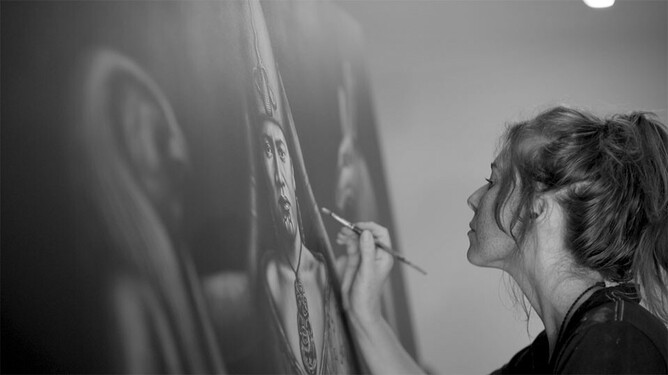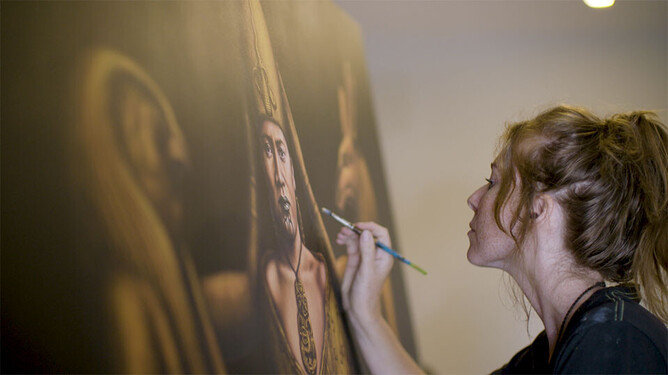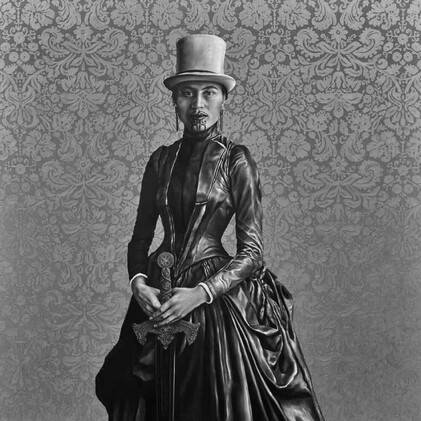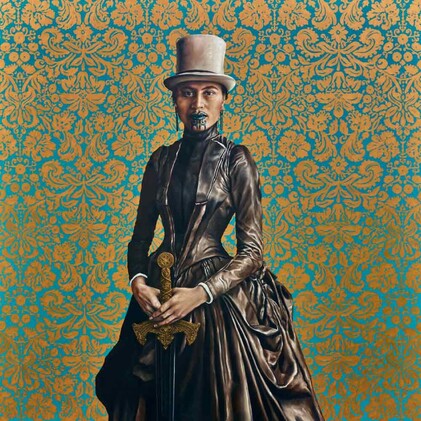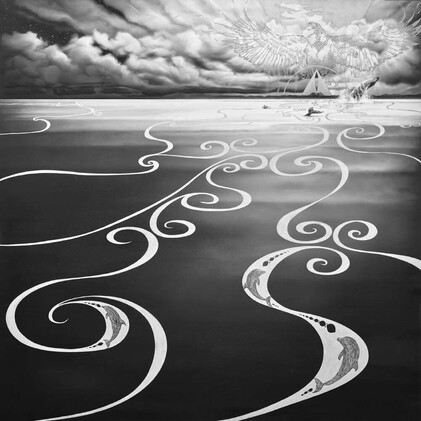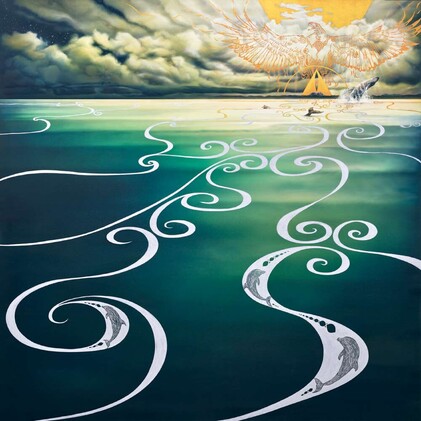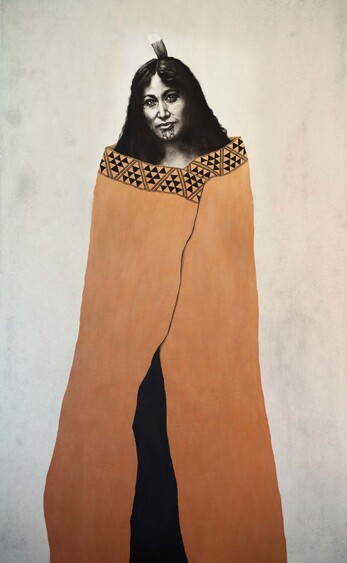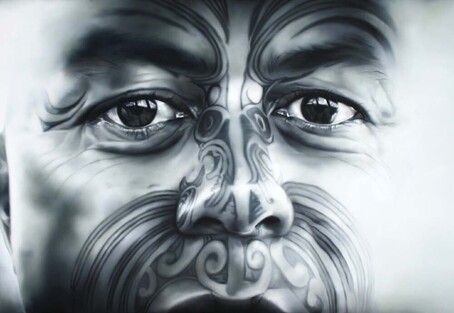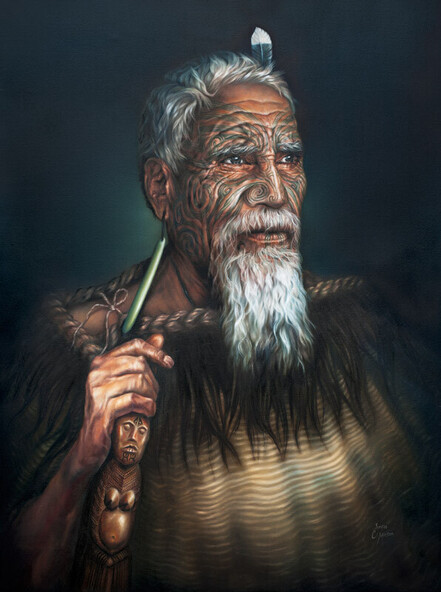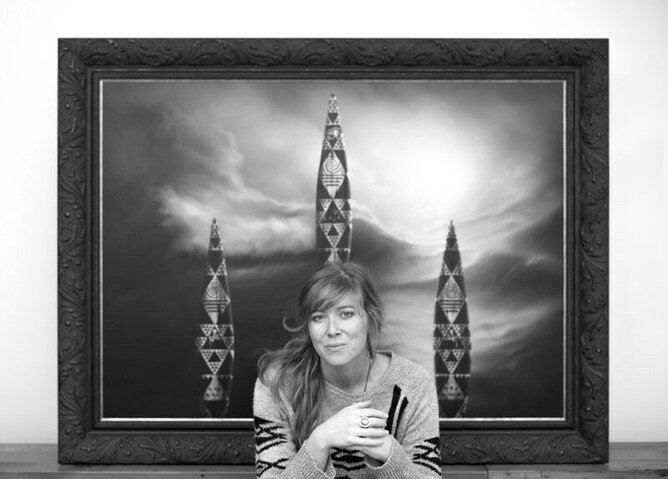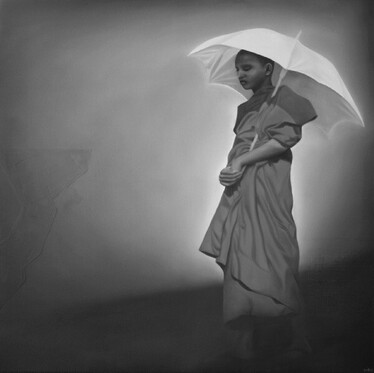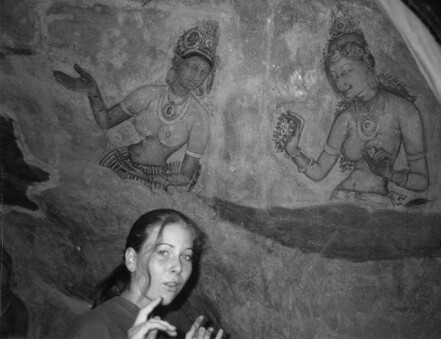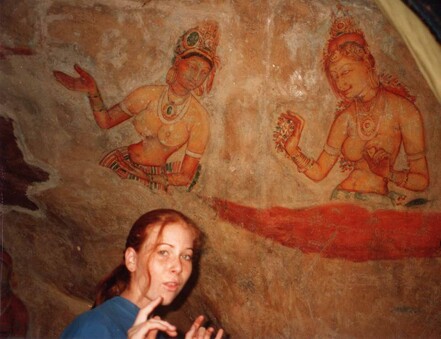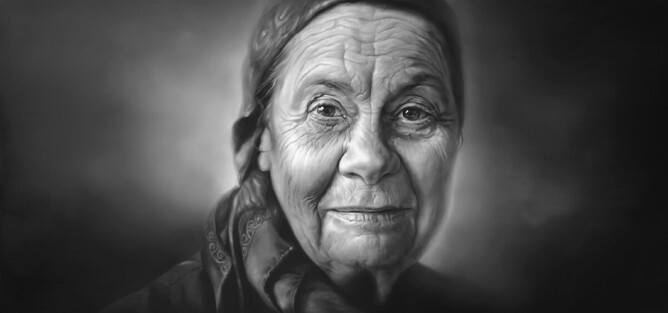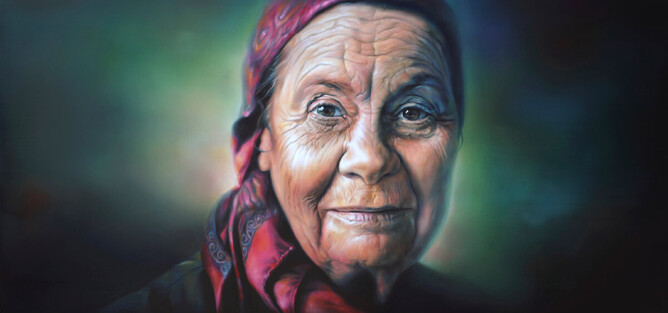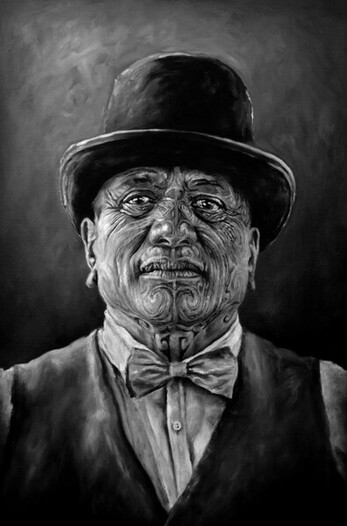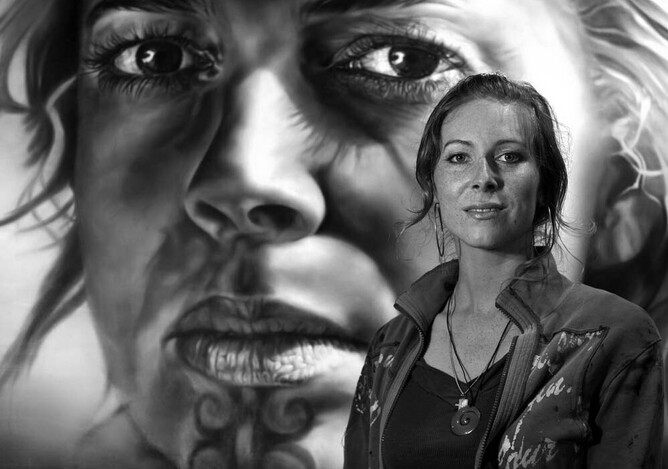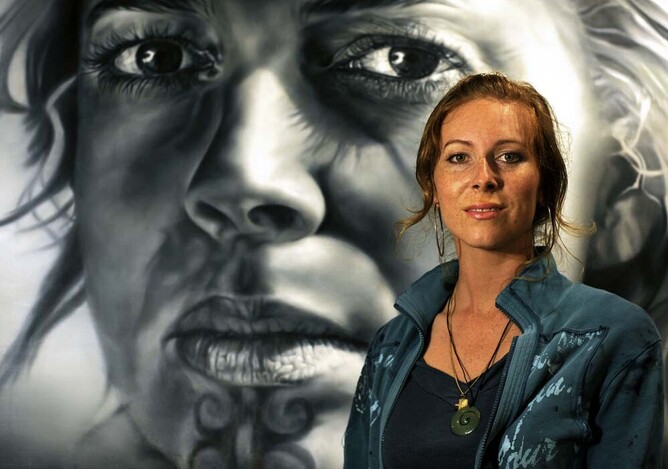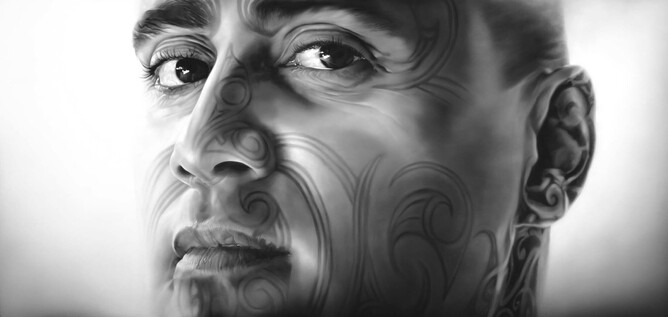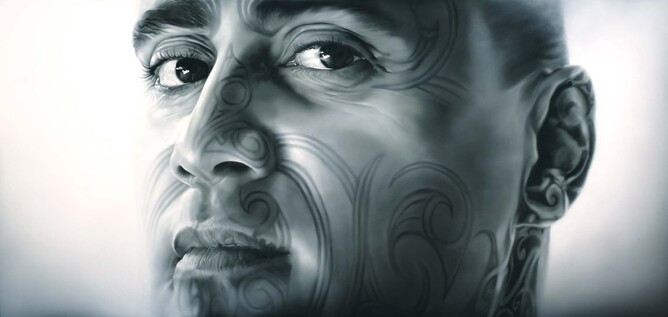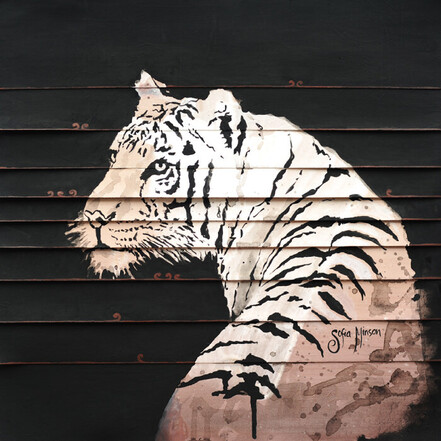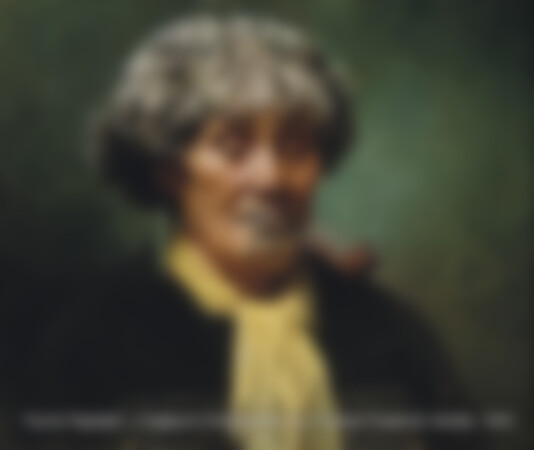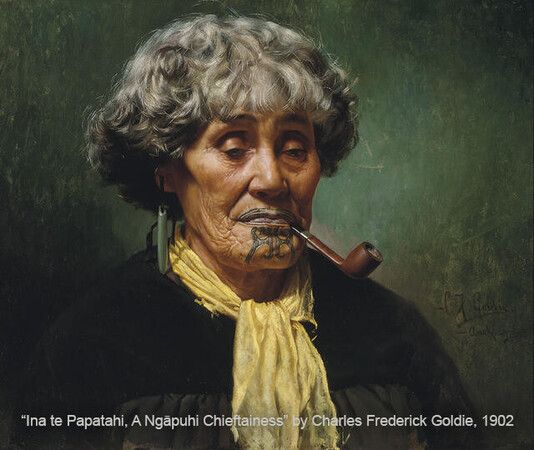A collection of the most interesting and most asked interview questions
I'd like to share some of my favourite and most-asked interview questions that I've had over the years.
It might be fun... you can get to know me better and lift the curtain a bit on that whacky process that is creating art!
It's also an opportunity to bring it all into one place as an open resource for all.
I've collected these Q&As from interviews I've had with all sorts of people over the years, from students doing art projects to bloggers to writers for newspaper, magazine and book publications.
If you're looking for a more general artist bio you can find it on my about page.
Enjoy the Q&A!
What inspires you to create your art with Māori subjects?
I have mixed Pākehā (Swedish, English and Irish) and Māori (Ngāti Porou) heritage, and I find myself living here longterm in Aotearoa after spending much of my childhood overseas.
Painting Māori portraits, myths, cosmology and landscapes from a Māori perspective, has probably occurred because this is the indigenous voice that calls out to me. It emerges from the land I live on and the culture I am embedded in. Living here and creating art inspired by this land has given me a strong foundation with my Māori spiritual roots and a chance to connect with this side of my ancestry.
In my young days I was searching for this kind of connection to land, spirit and ancestry. Now I'm on the journey, the connections just get deeper and wider, more inclusive and more cosmic.
I wonder what would have happened if I lived in Sweden or Ireland? Perhaps those ancient voices would have made it more prominently into my paintings? I feel this still might occur in time.
Which is your favourite painting you have done?
I would say that because I’m always looking to get better, evolve as an artist, change my style and keep moving, my favourite painting is always the one I’m about to do! As soon as I’ve finished a piece I move on to new ideas.
However I am drawn to certain pieces for different moods or different energies I want to bring into my life at the time. I see them all as sacred mirrors. The paintings themselves reflect back what I am calling in, into my own character or experience.
If I'm feeling the energy of autonomy, empowerment and standing my ground in my own alignment I love Sophia and The Hero's Journey. These are courageous wāhine toa that embody these qualities. I love how Sophia holds her sword in the centre of her stance. I see this as the ultimate proclamation of sovereignty.
If I'm feeling playful, free and connected to the beings of ocean, earth and sky, I turn to Hikurangi Rising. I felt exactly this exaltation and joy when I painted this piece early 2021. The living intelligence of water was the seed of inspirations for this piece, which grew from there. When I look at it I feel like I'm continuing to honour water and also the lives of my ancestors from the East Cape, which is featured in the painting.
When I'm going through a big challenge, change, death or transformation in my life my favourite paintings become Hine-nui-te-pō and Atua Wāhine, because both of these portraits conjure the archetypal energy of the goddess of death, of the long night, of the underworld, Hine-nui-te-pō.And so it goes through many other artworks and energies :)
.
Tell us about your painting journey. What inspired you to become an artist and how did you get started?
My painting journey began as a toddler. I have two older sisters, 10 and 12 years older than me, who I looked up to.
My sisters were artistic like my grandmother, so our house always had art materials around and I was constantly inspired by the pictures that they were painting.
When I came back to Aotearoa at 14 years old after living overseas, I was in a very vulnerable period of my life. I felt like a stranger in this land and was trying to construct an identity and sense of belonging in the world. I experienced such wonderful adventure and diversity overseas as well as the pain and separation of moving from place to place. I felt like I needed to find my own tūrangawaewae, my own place to stand, and to learn about my roots.
Painting was a way for me to connect with my ancestors, my mixed Ngāti Porou Māori, English, Swedish and Irish heritage, and to listen to my inner creative guidance.
In my teenage years I began painting images that told stories and in doing so, learnt about Aotearoa’s myths, history and magic. This provided me with a deep connection to the land and my place in the cosmos.
The plan was never to become an artist as a career though, because I had a false perception that you couldn’t make a living.
So I was studying sciences at university instead. But then felt such a strong pull back towards the arts that I decided to exhibit some of my paintings that I’d been creating just quietly at home and they began to sell. This was a shock! And it was the beginning of my journey as a professional artist in 2004, when I was 19. I took this as a green light from the universe that it was possible to create art full time.
Which piece challenged you the most, technically or emotionally, and how did you overcome that?
"Turumakina" took 2 weeks
Some pieces fly off the easel. Occasionally they emerge on the canvas so quickly and in a way, it's like I don't get to spend a lot of time with that particular energy. But I tend to trust the process and not attach too much.
A very fast piece which took me only 2 weeks to paint was the enormous oil portrait Turumakina. Don't ask me why, it just flowed out extremely easily.
"Kaitiaki" took 3 years
In contrast, Kaitiaki (portrait) who embodies Tāne Mahuta, god of the forest and progenitor of humankind, took 3 entire, long, looong, very long years! 2014 - 2017.
I would stare at the face of Kaitiaki and wonder who he was becoming. This was mirroring my life at the time.
I was going through a shift. I didn't want to be trapped into making art on a conveyer belt, feeling like a capitalist production machine. I no longer wanted to do art projects for the purpose of paying my mortgage.
He was teaching me many things. Most of all, he was inspiring me to slow down and relate to the earth in a new way.
It was during these 3 years that I would wake up in the middle of the night and watch "garden porn." I watched late-night permaculture docos and YouTube videos and I became obsessed with the living mycorrhizal network of the soil and the intelligence of plants and ecosystems.
I lived and breathed everything to do with local food sovereignty, biodynamic agriculture, food forests and urban permaculture.
My outflow of painting became so slow during this shift, that I honestly thought it might be over... my identity as an artist. I was starting to think I would go down a new path - permaculture.
How did I overcome the logjam in my painting life?
I changed how I established and expressed my boundaries as an artist. I stopped the temptation to paint "for the market" rather than for the sake of exploration and joy. And I said "no" to a lot of opportunities that no longer resonated with me. I needed to maintain total spontaneity in the studio. "No" can be the most powerful word in our vocabulary.
When I finally nurtured and rebirthed a playful energy for myself around art, the inspiration returned and it became fun again to be in the studio.
And voila! Kaitiaki was completed.
Good things take time. And I have a huge sense of gratitude to Tāne Mahuta and Papatūānuku who were present with me as I learned to relate to the living world in a new way
You have a unique blueprint – Ngāti Porou Māori, Irish, English and Swedish. What do you see as the key benefits of possessing this heritage as an artist?
Being born with mixed whakapapa that links me to ancestors and relatives all around the globe has meant that even if I’d wanted to, I haven’t been able to identify with just one perspective or group in terms of culture or history. I’m not on the right or wrong side of history - my ancestors have done both wonderful and terrible things to get me to where I am now.
With red hair and freckles and strong Māori spiritual roots, fortunately the canvas has offered me a space to heal some of the contradictory parts of who I am.
In search of spiritual sovereignty, I have been going through my own decolonisation and unlearning process. Like many of us in this day and age, I am bringing to light the wounds of separation, the trauma and the subconscious programming that no longer serve our generation.
When I am inspired to create art I feel expansive and I’m releasing my own limitations. I’m connecting with my ancestors and celebrating how incredibly supported we actually are when we let ourselves receive from the universe.
I believe that as we heal ourselves, we heal our lineages as well. Painting has allowed me to bring to the conscious world, a deep well of gifts, spiritual connection and cosmic wisdom from both my Māori and Western ancestors.
You draw inspiration from your family ties to the East Cape, Ohope and Opotiki. What is it about this particular slice of Aotearoa that resonates with you and your ethos?
I’ve been based in Auckland since my teens. With all the overseas travel early on in my life, it is the whenua (land), awa (rivers) and moana (ocean) of the Bay of Plenty and the East Cape that have been grounding for me over the years.
My mum was born in Opotiki and we used to visit my grandparents there regularly.
Then Ohope beach became the go-to for about 20 years of summers and holidays.
The flipside to having my eyes opened to other cultures around the world, is that I found it difficult to settle back into life here in Aotearoa and I felt rootless.
Touching base with the Bay of Plenty has been a consistent sense of homecoming and ‘time out’ to take care of myself and be close to nature, since I was a kid.
I had always explored my Ngāti Porou roots through my art.
It was when I was in my 20s that I realised I was well overdue to take my first pilgrimage to Hikurangi and Waiapu, the mountain and river sacred to my tīpuna (ancestors).
After a soulful sunrise experience on Hikurangi I received a whole lot of inspiration for new paintings. “The Navigators” was the first to be born in a long series of work, the most recent being “Hikurangi Rising” featuring the Waiapu river swirling into the ocean, met by ecstatic breaching whales and playful dolphins. My connection to the gifts and wisdom of my ancestors was strengthened by that first and many subsequent road trips I’ve made to the East Cape.
.
With every painting you do, do you set out to achieve an articulation of certain themes, messages, cultural myths or ideologies?
I paint intuitively, which means I am playful, spontaneous and led by my right brain in the studio. It is a nice and loose process and anything goes if I feel a sense of excitement about it.
As a piece starts to form, my pattern recognition and narrative forming left brain kicks in. I start to see symbols and threads within the piece that are highly synchronous and contain potent messages.
When a painting is finished and I get to stand back and soak it all in, I begin to write the story about the piece and give it a title. This is the final stage for me of birthing an artwork. The people, landscapes, gods, geometric patterns and symbols are woven together and anchored in this dimension with their own myth or story.
You lived and travelled extensively overseas, how do Kiwis compare in terms of art taste to other cultures?
The experience I’ve had with art markets and audiences overseas is through those who connect with my work.
My art is collected all over the world and what I’ve noticed is that whether my art buyers live in Hong Kong, USA, UK or Europe, they usually have a personal link to New Zealand. Many of them are expat Kiwis or have visited the country at some point and been blown away by our majestic landscape and resonate with the indigenous people. Those who have had a taste of Aotearoa are permanently impacted and yearn for art that reminds them of the essence of our land, nature and culture.
I hear from my international clients that on the worldstage, many New Zealand artists punch above our weight and create some outstanding taonga (treasures).
How did your international upbringing shape your art practice?
In my childhood, because of my dad's civil engineering work, we lived here in Aotearoa as well as years in Samoa, Sri Lanka and China.
The Sri Lanka experience particularly stands out to me as I was in a very formative period of life from age 11 to 14. The juxtaposition of different religions and ethnicities as well as the huge disparities of wealth and poverty was a culture shock. I attended an international school and my views were widened massively with the flooding of different perspectives from around the world. It shaped me as a person. I resonated profoundly with the idea of “unity in diversity,” which happened to be the slogan of my school over there. I became passionate about celebrating the uniqueness of people, their views, storytelling and spiritual practices and beliefs, which is something that has come through strongly in my art.
Equally, I felt very rootless with so much travel. Painting has been there for me, to help me reconnect with the land and my unfolding sense of who I am.
How much has your international travel and exploration influenced the trajectory of your pieces?
Since my teenage years, painting has helped me integrate the huge level of diversity that I experienced while living in Sri Lanka, Samoa and China with my parents during childhood. As an adult I also received so much inspiration from travelling through Egypt, South East Asia, America, Europe and the Middle East.
Similar to having a mixed whakapapa, living in very different cultures has enriched my philosophies and exposed me to so many different points of view. Artistically I have enjoyed exploring the threads of truth that resonate with me across many different traditions from East to West to the Pacific and beyond.
When I paint I’m in a flow state and I feel guided. With my imagination and paintbrush, faces will emerge over time onto the canvas. I engage with them as ancestors or cross cultural gods and goddesses.
Their faces and symbolism can end up spanning Māori, Egyptian, Celtic, Christian, Gnostic, Greek, Hindu and Buddhist pantheons of gods. In their own unique ways their energies are extremely connecting and healing. When we view these artworks they are like sacred mirrors, reflecting back to us powerful aspects of who we are.
.
What was the reason for your many relocations when you were younger? It must have been absolutely fascinating living in all those countries?
My parents' openness to explore the world and my dad's civil engineering jobs were the reason for moving countries when I was a kid. At that stage in their lives, mum and dad had a willingness to be uncomfortable and set up their lives in vastly different cultures than what they grew up in. I think they saw it as an adventure.
My two sisters are 10 and 12 years older than me so for much of my life, they were already off, exploring the world on their own. Before I came along, my sisters and parents began their international journey living in the Philippines.
I was born in Auckland, New Zealand. We relocated to Samoa when I was a baby. Then after a couple of years we headed back to NZ again. When I was 11 we moved to Sri Lanka, then back to NZ when I was 14. When I finished school at 17 years old we lived in China.
Yes it really was fascinating living in different countries and I am immensely grateful for the experience!
What took you to Samoa to live when you were born?
We flew to Samoa when I was 12 weeks old and lived in Apia for 2 years. Dad was doing an engineering project on the Apia airport runway.
I was a really little kid so I mostly "remember" it through family stories and photos.
I was told that the tropical sun gave me my freckles ;)
I was lucky enough to go back as an adult, 30 years later, with my mum and dad and we went down memory lane. We visited our little old crumbling house in Apia with its gorgeous avocado and papaya trees. It was post 2009 tsunami so we were also visiting some old friends to see how they were doing putting their lives back together.
It was absolutely magic going to some of the beautiful natural areas and swimming spots that I'd been hearing about my whole life.
What took you to Sri Lanka to live when you were younger?
As expected, I experienced a huge culture shock moving to Sri Lanka at 11 years old from little ol' NZ, where I was living at the time. It was my dad's engineering/telecommunications job that took us there. Looking back it was a massive eye-opener to another world of possibilities.
I was so sad leaving my life and friends back in Auckland but at the same time, those 3 years in Sri Lanka were some of the best experiences of my life.
The landscape. The wildness. The tropical environment. The oceans. Oh my goodness we spent a lot of time swimming and snorkelling. That oceanic realm is something I feel very calm and at home in.
I was so fortunate to join kids from all around the world at a beautiful international school, which very much celebrated our diversity and creativity and was a lot of fun.
It was pretty intense seeing the juxtaposition of extreme wealth and abject poverty existing side-by-side in Colombo, the city we lived in.
There was still civil unrest between the Tamil LTTE and the Sri Lankan government so there were some bombings in our city while we were there, but we were not harmed.
Another thing that stood out during those formative years of my life in Sri Lanka was the Buddhist and Hindu religions, which I was lucky enough to experience close up. I was able to visit many ancient sacred sites and temples.
Cows freely roaming the city streets was a regular site as they were considered sacred. Although the flipside of that is that they were often eating from piles of trash on the roadside.
We met so many great people there. The food was incredible - I got hooked on spicy curries for life. I really did love it there.
.
What took you to China to live when you were younger?
I love traditional Chinese paintings and calligraphy so living there was super inspiring for my future artworks, like "The Emperor's White Tiger" for example.
I flew to China when I'd just finished sixth form on the day of my 17th birthday. It was a liberating moment because I knew I wasn't going back to school for the final 7th form year. I loved my newfound freedom and I was open and dreaming about what I might get up to the following year.
It was super interesting in China. Mum and dad were there for year and I lived with them for several months in an industrial park in Suzhou, 2 hours drive from Shanghai.
There was a lot of seemingly endless concrete and construction going on in that area, including highrise apartment after highrise apartment building going up with hardly anyone living inside them.
China's such an enormous, varied country with a rich and deep history. The big cities were bustling with energy and I enjoyed the very ancient temples and sacred sites.
China also has so much beauty in the way of nature and landscape. I truly treasured the trips we did up to the Great Wall and seeing more of the open, natural spaces.
Did you study art or did you learn as you went along?
I learnt as I went along because art became a natural and enjoyable way to express myself. In fact, when it felt like it was becoming too structured at school I actually quit art in fifth form to pursue the sciences as a career presuming that art would simply remain a passion and a hobby rather than becoming my whole career.
At uni I studied science and then interior architecture.
In looking back, art seems to have kept its innocence and sacredness for me, it was always protected as a fun, playful, therapeutic part of my self-expression. It wasn’t until my early 20s, when I started showcasing my art to the public for fun, that I realised people would buy my work and this was a surprise to me. It chose me as a career rather than the other way round.
How would you describe the subject matter of your work?
I would say that I paint portraits, landscapes and images of nature that contain ancestral wisdom, integrated through my life and my brush, for our modern-day human experience. There are powerful characters, sacred geometry and myths and legends that connect us to the land and qualities possessed by our deepest selves. There are messages in there from beyond the veil of my conscious mind that remind us of our personal relationships with archetypes, energy, soul, spirit and unconscious and collective consciousness.
I am fair skinned with freckles and red hair and my portraits reflect my inner experience with cultural diversity. Many are of Māori or portray gods and goddesses from Māori cosmology. My creativity is inspired by living here in Aotearoa and tapping into my Ngāti Porou lineage and ancestors, so these are the stories coming through to me the strongest at this time. There is a symbolic storytelling element that comes through every piece, whether it’s an image of nature, people, animals or birds.
What inspires you to start a painting?
Sometimes a certain feeling or excitement inspires me. It’s something that I can find by paying attention to my body and emotions and dropping down into my centre, into my soul space, where I receive inspiration.
Reaching this place is helped by taking walks in nature, being amongst trees, looking at the sea and water and getting into a flow state. I practice dropping out of my limited sense of self and into a larger one, where I feel like I’m so much more than I was pretending to be. I become expansive. When I'm in that oceanic state I feel like having fun and going into the studio and making something. There’s a loving, supportive non-judgmental presence there and you can’t do anything “wrong”, you can only be playful and know that it is right. I get a feeling of satisfaction, happiness and connection when I paint.
I’ve tried painting to complete projects when I'm not in that flow space and it’s difficult. Nowadays I don't force it and don't try to paint, I’ll do something else until the energy returns.
With your portraits, how do you decide who to paint and how to portray them?
Gods and goddesses
Many of my portraits are of the faces of gods and goddesses who are not physical people who I have met, but presences that emerge onto the canvas from the imaginal realm. The facial features and forms of these imaginal portraits are often influenced by my own face and eyes and the faces of my ancestors. These portraits help me to tell cosmic, mythical and archetypal stories.
People who are living today
Other times I am blessed with the opportunity to paint people who I know and have met, such as “Dame Joan Metge,” "Tame Iti," my sister Tess for the painting entitled “The Other Sister,” or “Tiki Taane.” These are all very different situations.
Dame Joan Metge
For Dame Joan Metge I was approached and commissioned by the New Zealand Portrait Gallery to sit with her and create a portrait for their collection, as a historical record of her. This was a huge honour of course and I learned so much through my meeting with her.
Tame Iti
I'm sure Tame Iti doesn't remember it but my mum and I had a quick kōrero with him in a supermarket in Whakatane once upon a time. In 2012 I met with photographer Jos Wheeler and had the opportunity and consent of Tame to paint a portrait of him modelled off Jos' photograph of him outside the High Court.
I felt honoured to paint Tame Iti's portrait. There is depth and mana coming from Tame's face - from his moko and his eyes. As he must have been intending when he wore that outfit to court, the bowler hat and bow tie add a theatrical sense of the colonial.
My sister Tess
With my sister it was a very different project in that I was interested in exploring our family mixed heritage and asked her if she would mind being a subject for a new painting.
Tiki Taane
Tiki Taane I was already connected with and we had mutual interests in exploring the meaning of whakapapa in contemporary art and life as well as the artform of ta moko. So I asked if he would sit for me, which he generously did. He used my oil painting of him for his 2012 live album "With Strings Attached." I've created several artworks of him over the years:
- A 40ft shipping container in downtown Auckland
- "Freedom to Be" (oil painting)
- A huge 9x15 metre paste-up on a building
- "Tiki Taane" (oil painting)
.
What inspires you to do specific painting?
My inspiration for particular pieces combine deep seated interests that I have about my ancestral roots (Ngāti Porou Māori, Swedish, English and Irish) and diverse cultural influences with images and ideas that I’m encountering in daily life that look cool and get me excited about creating something visual.
As an example I'll use the painting Mauri of the white tiger. This explores and contrasts Māori and Chinese influences. It is a mix of Māori spirituality and the concept of mauri, or the energy force in all things, with the Chinese symbol of the white tiger.
Symbolism - shapes, animals, designs etc - is a huge part of what inspires my work, or what enhances the work with layers and layers of meaning. All of my work deep down is inspired by an inquiry into the nature of the universe, a curiosity about spirituality and what it means to be alive!
How do you rest, recharge and stay inspired?
Over the 15 or so years that I've been professionally painting, I’ve learned that it's not about force and you can't force being in the flow. Painting is meant to be a fun and playful act and, when I’m in the studio, I’m not judging myself. Anything that comes up and anything I paint is totally fine and I practice ignoring any external voices of judgement and working on releasing any internal ones.
When im not in that feeling of flow, I will rest. Life isn't about working super hard when you feel uninspired. In those times I would change my environment, travel, go for walks in nature, spend time with loved ones and go out for food. I love absorbing stories so I spend time reading books and watching movies. The contrast is really nice and it's like I get my fix of the outside world and then I want to go inward and paint and produce something, since I now have something new to say or explore.
Are there any particular techniques or styles that you use and where did you learn them?
I went through a phase of doing very softly blended misty landscapes in oil paints and this was definitely inspired by NZ landscape painter Tim Wilson. The actual technique that I developed for that style however, was through trial and error in the studio. It always has been. Trial and error and experimentation has been the most fun way to learn.
Another style I use is watery washes of vinyl paint creating what look like watercolour portraits, landscapes and animal paintings. Again this was from playing around with paints, seeing how they absorbed onto the canvas and merged when I started watering down the paint a great deal. If it didn’t give me the “look” that I wanted, I would try a different ratio, or google binding agents that you can add to strengthen the glue-like quality of paint that has been watered down, so it stays stuck to the canvas grain.
I find that play is the best way to learn. This is because something unexpected always comes out of it and quite often you find yourself creating something completely original, using an original technique that you’ve developed yourself!
What other visual artists are you inspired by?
Visual artists I’m inspired by include...
Visionary artists like Alex Grey
I respect painters who are creating their own personal version of sacred, psychedelic art.
They're bringing back knowledge from beyond the veil of our conscious mind. I see them as image setters who are showing us an expanded perspective of our human selves and our inter-connected psyche. I find it really inspiring that they are willing to journey into the unconscious and share that with the collective.
Painter Tim Wilson
My soft, misty oil painting technique that I used a lot prior to 2015 was inspired by Tim Wilson's beautiful, mountainous New Zealand landscapes.
Lindauer and Goldie's Māori portraits
Historical painters Gottfried Lindauer and C.F. Goldie are important influences on my portrait work.
These 19th and 20th-century Western artists painted exquisitely poignant Māori portraits for their generation. In that time many believed Māori were going the way of the huia - into extinction. Nowadays Māoridom is alive and dynamic so I, as a Māori artist, am creating modern contemporary portraiture from a Māori perspective. I navigate some difficult historical tensions in my art by integrating my modern experience of the world and my life as a mixed blooded person, using both Western and Māori themes and motifs.
Ancient esoteric art
I'm not sure who the artists are but I'm profoundly influenced by images that I find of ancient, esoteric art. Ancient Hermetic, Egyptian, Pacific and Asian drawings, sculpture, carvings and paintings have all inspired my work.
What other kinds of creatives are you inspired by?
Speaking more broadly than just visual artists, my art is inspired by so many other kinds of creatives as well...
Podcasters
When I'm not listening to music while I'm painting I listen to podcasts, so I consume a huge amount of long-form conversations. It gives my conscious mind something to chew on while I'm painting from my imaginal realm or unconscious.
Comedians
I'm especially inspired by comedians because they tell raw truths and perform this magical alchemy with it.
They take the pain, suffering and dark side and reveal it for all the world to see. We laugh and raise the energy of that subject that was hidden. I love how it moves tension through the body and releases it.
Healers, philosophers, magical practitioners and scientists
I am inspired by so many healers, philosophers, magicians, witches, magical practitioners, psychic mediums, channellers, scientists, researchers and thinkers. All of these people in one way or another are questioning our culture and investigating the nature of reality and how we are relating and engaging with it. I love getting my mind blown and furthering my personal growth.
Musicians
I’m inspired by musicians too and their stories about being in the flow state to create their art.
Who were your role models in this industry?
I love visionary artists like Alex Grey but not sure I have too many role models in this current “art industry” as such.
In terms of historical painters who have had an impact on me - I admire Lindauer and Goldie. They have been huge influences on my portrait paintings. And I felt it was also time to update their 19th century European portrayal of Māori through portrait art. It is time for Māori stories to be expressed from our own perspective, by Māori artists.
What is your favourite painting by someone else? And who?
This is a hard question for me because I don’t actually look at a lot of other artists’ work or go to exhibitions. When I research images for my own work I am putting together meaningful symbols and creating new compositions. I would say the biggest influence on my work (rather than my favourite) has been C. F. Goldie purely because he painted Māori portraiture and I do as well. His work is a snapshot in time. His portrait of Ina Te Papatahi (1902) keeps coming up as an important one for me over the years.
Ina te Papatahi lived at the Waipapa Māori hostel in Mechanics Bay, Tāmakimakaurau / Auckland, not far from Charles Goldie’s Hobson Street studio. She sat for him many times, the first time in 1902.
The niece of prominent Ngāpuhi rangatira (chiefs) Eruera Maihi Patuone and Tāmati Waka Nene, both signatories of the 1840 Treaty of Waitangi, she was well-connected and introduced Goldie to many other Māori who agreed to sit for him.
Ina te Papatahi was later remembered by Goldie’s friend, the writer and historian James Cowan, for her “very likeable nature”, “keen sense of humour” and the “great interest [she took] in the painting of her portrait”.
(Te Wheke, 2020)
If you hadn’t been a painter, where do you envisage your career path may have journeyed?
Three alternate timelines jump out at me…
Alternate Timeline 1: Quantum Physics
I began a science degree when I was 17 because (as per myth 1) I thought artists were poor. I was attracted to quantum physics as I was searching for a model of the cosmos that rang more true to me. The reality presented in Newtonian physics and reductive scientific materialism in school books, in my family culture, and throughout the contemporary Western culture that I grew up in, seemed far too limited. So perhaps instead of dropping out to pursue my art I could have carried on with that degree and through the lens of quantum mechanics, marvelled at the mysteries and paradoxes of the universe.
Alternate Timeline 2: Marine Biology
I used to dream of being a marine biologist because I’ve always loved whales.
Alternate Timeline 3: Permaculture
A huge interest of mine, which could have turned into a career path, is permaculture and biodynamic, syntropic agriculture. I enjoy learning about these systems of living in a holistic way with thriving, nutrient dense food production and biodiversity.
In a world that is tech dominated, do you have any fears or concerns for the future workforce of artists here Down Under – do you worry many won’t want to pick up a brush?
I think that technology is brilliant if we intentionally keep the heart in what we do. We could be talking about tech that we use to communicate with each other such as zoom, or tech that helps us express ourselves creatively such as design and drawing apps. The saving grace I believe is to bring our true inspiration and authenticity to every tool or modality that we engage with.
Painting is certainly not the only valid form of visual art. For example, I think memes are an amazing modern artform that instantaneously transmit packages of information with loads of context, humour and lightbulb moments. Memes are kind of like telepathy where we don’t need to use long linear sentences to communicate ideas. Come to think of it, paintings are like this too! There’s nothing like visual symbolism to bypass the conscious analytical mind and speak directly to the primordial, transpersonal subconscious.
Personally, I like painting with dripping paint on the rough surface of a canvas precisely because it is tactile. It is my meditation and my dance that brings me more deeply into my body. It helps me ground my internal and extra dimensional experiences into this reality through my body, through my hands and through my paintbrush.
It is for every artist to follow the modality that excites them the most. I think new generations will be creating art with tech that we never even dreamed was possible.
And where we are going, I believe eventually our paradigm will shift so that we won’t need to think of ourselves as a workforce. This starts within, with how we view and value ourselves.
The greatest material, financial successes I have had are when I am playful with my art and evolve freely in the commercial world, forging my own path with trial and error, never fearing a changing world. Also ignoring the naysayers! As all the greats throughout history have said, from Buddha to Heraclitus, “the only constant in life is change.”
What's your favourite colour?
Gold at the moment. It always changes. I remember I went through a blue period for a year or so and all my paintings including the portraits, were blue. Then there was a pink period and I painted a lot of pink and white terraces landscapes.
Gold for me symbolises alchemy - metaphorically going to the depths of the underworld and retrieving the gold that is guarded by the dragon.
It is the solar plexus chakra, it is our will, our sense of "I am." It is our inner sun.
It is also the literal sun, that is one of the most vital forces creating the glorious condition for life to flourish on this planet.
Do you have particular music that you listen to while you paint?
I love blues and 60s soul music. I get a heart opening feeling from listening and chanting to the Hare Krishna maha mantra. Sometimes I listen to whale sounds. Other times the rhythm of contemporary indigenous dance music puts me in an upbeat flow state.
Most of the time listen to podcasts and audiobooks while I paint because it’s just so so so many hours of painting at a time. So I like to hear stories and learn about interesting things while I paint.
Do you have a weakness in your artworks? E.g feet or faces…
I would say I’ve never had the patience to paint individual strands of hair! So even if I’ve done a really detailed portrait of someone’s face I leave the hair till the end and then just paint the bare minimum of detail required.
Same goes for trees. I like the idea of painting lush trees with lots of foliage but I can’t be bothered painting so many leaves. The painting Kaitiaki - landscape took me forever for this reason and was painful at times doing the detail.
Do you have a favourite inspirational quote that you would like to share?
“We're not on our journey to save the world but to save ourselves. But in doing that you save the world. The influence of a vital person vitalizes.”
― Joseph Campbell
I love that quote because it essentially says never stop working on yourself. And by learning and getting to know who you are better, and by doing what you enjoy doing, you naturally radiate love into the world and there’s a ripple effect to that. When I was young I used to get worried about righting all the wrongs of the world and I would feel overwhelmed because it’s an impossible task. Now I just try and be my authentic self, in the moment, and it turns out that’s far better for everyone around me too.
Why did you decide to start selling prints as well as original paintings?
I decided to sell prints because I love the fact that the messages of connection that come through my original paintings can reach more people. Because of limited edition prints, my work is accessible at a different price point and scale to the originals, yet they are still valuable pieces of art in their own right that can be treasured and enjoyed in the home. This has opened up so many new relationships between myself and people who love my art. And when I find out my work is meaningful to so many people out there it blows my mind and makes me incredibly happy. So that’s why we started prints!
What does a normal working day look like for you?
My working day changes throughout the year based on levels of inspiration or where I am being led within myself. Sometimes, I drop down into a creative soul space for a number of weeks and that working day is quite homely. I like to spend time by myself and with my cats and my family and enjoy being in nature.
My studio is below my house which also creates that sense of dropping into another world or dimension. I start by gazing for ages at the canvasses and pieces around me and then I will paint for the whole day. It's my most blissed-out day when I'm in the painting zone/ creative zone.
At other times I might be in an adventurous mode where no painting is done but there’s a lot of personal growth and inspiration while I explore new environments and travel around NZ.
And on the flip side, sometimes I'll need or want to be front-facing and do a lot of socialising or be more involved with the business.
Often there'll be more admin-heavy days, which looks more like posting on social media, checking and responding to emails, ordering limited edition art prints from my printer for new customer orders and ordering courier pick-ups for prints. Luckily we have been able to hire someone to help us with admin and my hubby and I both run the art business together.
Sometimes part of my creative process is that I'm on my computer designing new artwork compositions using photoshop (I don't draw with paper and pen that often).
I also do quite a bit of research and writing on painting concepts.
There are different hats that I wear and it allows me to express different sides of who I am.
Any typical myths you’d like to bust that are associated with the life of an artist?
There are a million myths I’d love to bust! Here are 3...
Myth 1:
Artists are poor.
Busted! You can create your own path, unique to you. Heal your own lack mentality first. Money is just energy. Living in abundance is about learning to ride the waves of money coming in and money going out. Gone are the Van Gogh days of cutting off our ears and living in squalor.
Myth 2:
You need to follow a particular path to success as an artist through institutions, funding grants, hierarchies, and gatekeepers.
Busted! Again… you can create your own path, unique to you. Paradigms of learning and doing business are swiftly changing. If everyone isn’t co-creating in commercial or educational relationships and profiting happily, something’s got to change. Perhaps there are loud authoritative voices from the establishment still championing old ways of doing things that no longer work today. Perhaps you have a map to a new way of educating yourself and a new model of doing business that is more true for you.
Myth 3:
You need to create what other people want to buy.
Busted! Switch that around. I’ve never shut down creatively so hard as when I’ve tried to paint for the “market.” The “market” was in my head and it was like giving myself a boss when the whole point of being an artist was that I didn’t need one. Everyone’s different but I’ve found it more fun to create what you love, build up a collection of art and then put yourself out there. Online, on social, on a website and collaborating with gallery partners are all great options. Your art will find its audience. There are 8 billion people on the planet. Not everyone has to love what you do. But someone will.
Do you have any tips on how to be more creative?
I would say being more creative just means giving yourself the space, the time and the attention, to get into a creative spirit. You need to create safe, uninterrupted times when you can fully let yourself get “into the zone” as they say. This might mean going for a walk and then coming home to play around with your materials. It’s very important to take away expectations of the importance of the final product while you’re in that zone. Don’t do it for a good grade, to create a masterpiece, for praise from teachers, parents or peers. Just create your art because you find it fun, that’s all!
How did you go about building a career as a painter? E.g. How did you get in front of galleries and buyers to start with
Initially the first opportunities career-wise came to me without effort because I loved painting and had amassed a huge portfolio of work, purely for fun. At 19 my path was ripe to attract an outward success that reflected my inner creative enjoyment.
I began to meet some generous people with great advice for me in these early years. They led me in the direction of setting up an online presence with my extensive portfolio of work. This was 2003 and people began to discover me through my website, inviting me to showcase my art publically. The first time was nothing fancy, but it was perfect for me. I was offered a leftover booth, for free, at a women's expo at ASB showgrounds in Auckland, to display my work. Low and behold, over the course of one weekend, all of my paintings that I’d been working on for the last couple of years, sold.
Prior to this, I was under the common misconception that you can’t make money as an artist but, when people bought my work at that show, I realised that I could start pursuing it as a career and actually sustain myself from my passion.
Early on in my career, the main thing I did was to put myself out there all the time. I entered (and won a few) art awards and put my work in every group exhibition I could. I wrote press releases about my personal story as an artist from a variety of interesting angles, so magazine, newspaper, and TV interviews with me began to pop up in the media. Because of group shows, art awards, press and my web presence, galleries began contacting me wanting to represent my work and followers of my art grew over the years organically.
Looking back, I seem to have had unlimited energy for this way of doing things, which gave my career an initial push and began turning the wheel. The way I do things has naturally changed over time as I have changed, momentum has built, lessons have been learnt, and my desires have changed.
Since those early days, I’ve had many solo exhibitions here and internationally and have been involved in heaps of cool projects from documentaries to collaborations to public art installations.
What advice do you have for other artists?
Follow your own path
I grew up with the false notion that artists are poor and you can't make money and you have to be chosen or plucked by some imaginary hierarchy. What the world is learning is that often these external authorities we give our power to are imaginary and we can make our own paths by putting one foot in front of the other and following our gifts and talents. There's not one particular gallery you need to be represented by or one perfect institution to study at - there isn't a set ladder or hierarchy you need to climb. Find your own path. Be the happiest that you can be.
Balance creativity and business
Another thing is that after a couple of decades of doing this professionally, I'd say you continually have to foster and protect your purely creative and vulnerable side, just as much as you need to push for sales and exposure of your work. It is a balance between creativity and business.
What do you like and not like about this career?
I like that I'm my own boss.
As an artist I get to research and learn every single day. It is like my university for the rest of my life. I investigate topics that are truly interesting to me, rather than subjects that I'm being told are important by an employer, parent or educational institution. For me this means I delve deeply into the richness that comes from learning about diverse cultures, including my own mixed Maori and European heritage.
Also I find that art is a perfect expression of both scientific and spiritual concepts. I don't have to choose just one field of inquiry. I combine both scientific and spiritual ideas in my art.
There's nothing I don't like about this job. There are challenges that I am grateful for however. These challenges push me to grow as an individual and become a better person. Sometimes I don't get it right. But then I just try again the next day. I used to be very hard on myself, especially during my teenage years, and negative thought patterns took me down some dark emotional spirals of depression. I've learned to be much kinder to myself as I've become older. This makes me a more loving person to others as well.
One thing I find challenging is being disciplined to wake up early. I'm usually a night owl but feel healthier when I get into a good routine of waking up early. This is the difficult side of being your own boss, you have to stick to your own schedule. There's no one telling you what to do.
It takes a certain love of freedom and autonomy to be an artist.
The other challenging thing is spending a lot of time in the studio by yourself. I actually love this, but sometimes when my mood changes, I feel like it might be nice to be around a group of other people, working on a project together. This can be achieved by painting in a shared space rather than at home as well as doing collaborative artworks, which I do sometimes. However the downside to working in a shared studio space away from your house is that you can't wake up in the middle of the night with a stroke of inspiration and just go straight into your studio and start painting!
What skills would be helpful to do art as a career?
Playfulness
A love of art and a desire to make art for fun, whether it is your job or not.
Writing
It helps if you can write your own artist bio, artwork descriptions and even write your own press releases when you are starting out professionally.
Willingness to have ease with money
I feel to keep it sustainable, it is important to examine your own relationship with money. Art is a volatile profession. One month you're making heaps of sales, the next month you might earn nothing.
My own relationship with money has changed over time. I used to attract lots of sales and then save, save, save, so there was plenty there during the low-income times.
Nowadays I'm more into perceiving money as energy and not getting constipated in either direction. To be in the flow of abundance, means relaxing rather than contracting, whether money is coming in or going out. The most important thing here is actually to not obsess on the money, but to practice staying in the heart space and in the joy of creating what you're painting in the studio.
Taxes
You also need to learn about how to do your own taxes. Eeek!
Trusting your creative intuition
One of the most important skills is to follow your heart and your own creative voice rather than producing art that other people are telling you to do. This is because you need to be authentic otherwise what is the point of being an artist? If you're not being authentic then you may as well get a 9am-5pm office job somewhere. Foster your creative spirit!!
What kind of person does this job suit?
Someone who loves to create art, draw or paint. Someone who loves their freedom and independence to choose their own path. Someone who doesn't like getting told what to do by authority figures! Someone who is willing to work on themselves every day for the rest of their lives, and who is ultimately curious about the nature of reality.
